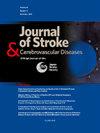Differences in door-to-device times in a retrospective cohort of patients with ischemic stroke who received CTA only or CTA and CTP imaging
IF 1.8
4区 医学
Q3 NEUROSCIENCES
Journal of Stroke & Cerebrovascular Diseases
Pub Date : 2025-03-13
DOI:10.1016/j.jstrokecerebrovasdis.2025.108272
引用次数: 0
Abstract
Background: In the treatment of acute ischemic stroke, there are differing views about the utility of computerized tomography perfusion (CTP). Two approaches are employed depending on hospital preference. The first approach is to perform non-contrast computed tomography (CT) scans followed by vascular imaging with computed tomography angiography (CTA) for patients arriving within 6 h of last known well. In the first approach, CTP is reserved for patients who arrive 6-24 h after last known well. The second approach is to utilize both CTA and CTP regardless of the time window in which the patient presents. In this study, we sought to answer whether patients triaged with CTP and CTA had increased door-to-device times compared to those only triaged with CTA.
Methods: We investigated a retrospective cohort of 1,357 patients with ischemic stroke who received endovascular therapy (EVT) and were triaged with CTA only or CTA and CTP. Patients were stratified by when they arrived at the hospital (<6 h and 6-24 h from last known well). Linear mixed-effects models (LMM) were used to investigate the association between door-to-device times and CTA/CTP usage.
Results: Our results showed that using CTP and CTA was not associated with increased time to treat compared to CTA alone. There was no increase in time from door to device in patients presenting within 6 h. Furthermore, for patients who arrived 6-24 h of last known well, the use of CTP and CTA was associated with an accelerated time to treatment with EVT.
Conclusions: CTA and CTP usage was not associated with added time costs with respect to door-to-device in this patient cohort. Our results are consistent with other data showing that radiologists have faster read times when given both CTP and CTA. It is noteworthy that the majority of EVT patients in our dataset (70.6 %) presented in the <6-hour time window.

仅接受CTA或CTA和CTP成像的缺血性卒中患者的回顾性队列中门到设备时间的差异
背景:在急性缺血性脑卒中的治疗中,对计算机断层扫描灌注(CTP)的应用有不同的看法。根据医院的偏好,采用了两种方法。第一种方法是对在最后已知的6小时内到达的患者进行非对比计算机断层扫描(CT),然后进行血管成像和计算机断层血管造影(CTA)。在第一种方法中,CTP保留给最后一次熟悉后6-24小时到达的患者。第二种方法是同时使用CTA和CTP,而不考虑患者出现的时间窗口。在这项研究中,我们试图回答接受CTP和CTA分诊的患者是否比那些只接受CTA分诊的患者增加了门到设备的时间。方法:我们对1357例接受血管内治疗(EVT)的缺血性脑卒中患者进行回顾性队列研究,这些患者分别接受CTA或CTA + CTP治疗。患者按到达医院的时间进行分层(距最后已知地点6小时和6-24小时)。使用线性混合效应模型(LMM)来调查门到设备时间与CTA/CTP使用之间的关系。结果:我们的结果显示,与单独使用CTA相比,使用CTP和CTA并不会增加治疗时间。在6小时内就诊的患者,从门到装置的时间没有增加。此外,对于最后一次已知的6-24小时到达的患者,使用CTP和CTA与EVT治疗的时间加快有关。结论:在该患者队列中,CTA和CTP的使用与门到设备的时间成本增加无关。我们的结果与其他数据一致,表明放射科医生在同时接受CTP和CTA时阅读速度更快。值得注意的是,在我们的数据集中,大多数EVT患者(70.6%)出现在6小时时间窗口内。
本文章由计算机程序翻译,如有差异,请以英文原文为准。
求助全文
约1分钟内获得全文
求助全文
来源期刊

Journal of Stroke & Cerebrovascular Diseases
Medicine-Surgery
CiteScore
5.00
自引率
4.00%
发文量
583
审稿时长
62 days
期刊介绍:
The Journal of Stroke & Cerebrovascular Diseases publishes original papers on basic and clinical science related to the fields of stroke and cerebrovascular diseases. The Journal also features review articles, controversies, methods and technical notes, selected case reports and other original articles of special nature. Its editorial mission is to focus on prevention and repair of cerebrovascular disease. Clinical papers emphasize medical and surgical aspects of stroke, clinical trials and design, epidemiology, stroke care delivery systems and outcomes, imaging sciences and rehabilitation of stroke. The Journal will be of special interest to specialists involved in caring for patients with cerebrovascular disease, including neurologists, neurosurgeons and cardiologists.
 求助内容:
求助内容: 应助结果提醒方式:
应助结果提醒方式:


